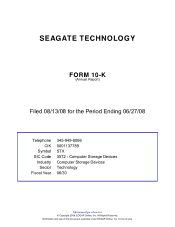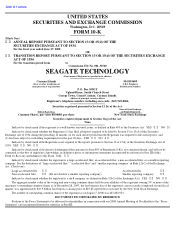Seagate 2007 Annual Report Download - page 8
Download and view the complete annual report
Please find page 8 of the 2007 Seagate annual report below. You can navigate through the pages in the report by either clicking on the pages listed below, or by using the keyword search tool below to find specific information within the annual report.
Table of Contents
Demand for Disc Drives
While the disc drive industry has traditionally been focused on applications for the enterprise and compute markets, we believe advances in
disc drive capacity, cost per gigabyte, power and ruggedness have enabled growth in demand for digital content. These technological advances,
as well as a proliferation of non-compute applications in the consumer electronics market, has increased the demand for disc drives used in
consumer electronics applications or has indirectly driven the demand for additional disc drives to store, host or back up related media content
created by such applications.
Disc drives are presently the most common storage solution in enterprise, desktop, mobile and higher capacity consumer electronics
applications. We are particularly focused on the following areas of growing demand for disc drives:
Disc Drives for Mobile Computing. The mobile computing market is growing faster than the market for desktop computers as price and
performance continue to improve. Notebook systems are increasingly becoming the preference for both consumers and enterprises as the need
for mobility increases and wireless adoption continues to advance. We estimate that in fiscal year 2008, industry disc drive shipments for mobile
compute applications grew approximately 45% from fiscal year 2007.
The disc drive industry has recently seen the introduction of alternative technologies that directly compete with mobile disc drives. For
example, certain manufacturers have introduced SSDs, using flash memory technology, which is an alternative to disc drives in certain
applications. Due to the high capital requirements and capacity required to manufacture flash memory, we believe the perceived benefits of
SSDs are not currently realized at an attractive cost relative to hard disc drives, particularly in higher capacity applications. We believe that the
market for these alternative technologies is still developing and because of the current high cost per gigabyte of these storage solutions, we do
not expect these solutions to have a significant near-term impact on the overall market for disc drives for mobile computing.
Disc Drives for Enterprise Storage. The need to address the expansion in data storage management requirements has spurred the
evolution of new storage and data management technologies for both mission critical and business critical enterprise storage.
Mission critical enterprise storage is defined by the use of high performance, high capacity disc drives for use in applications which are
vital to the operation of enterprises. We expect the market for mission critical enterprise storage solutions to grow, driven by many enterprises
continuing to move network traffic to dedicated storage area networks (SANs). In addition, many enterprises are moving away from the use of
server-attached storage to network-
attached storage (NAS). Both of these solutions are comprised principally of high performance, high capacity
disc drives with sophisticated software and communications technologies. In addition, many enterprises are also consolidating data centers,
aiming to increase speed and reliability within a smaller space, reducing network complexity and increasing energy savings, which has led to an
increased demand for more energy efficient, small form factor disc drives. SSD storage applications have been introduced as a potential
alternative to redundant system startup or boot disc drives. In addition, enterprises are considering the use of SSDs in applications where rapid
processing is required for high volume transaction data. The timing of the adoption of SSDs in these applications is currently unknown as
enterprises weigh the cost benefits of mission critical enterprise disc drives relative to the perceived performance benefits of SSDs.
Business critical enterprise storage is an emerging and growing application in enterprise storage whereby enterprises are using higher
capacity disc drives to store less frequently accessed, less time-critical, but capacity-intensive data. Because of recent decreases in cost per
gigabyte, business critical electronic data, which historically has been stored on tape or other backup and archival technologies, are now being
stored on these high capacity disc drives. In the long-term, however, we believe that this trend towards business critical systems that utilize high
capacity, enterprise class serial advanced technology architecture (SATA) and serial attached small computer system interface (SAS) will, in
addition to expanding the overall enterprise market, likely shift some demand from disc drives used in traditional mission critical enterprise
storage.
7





















